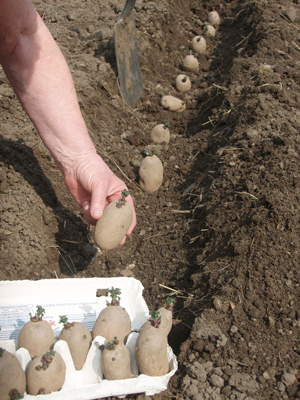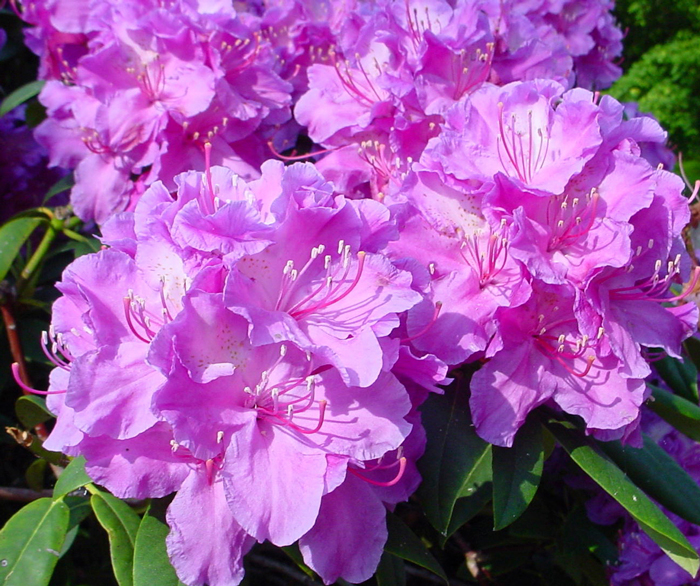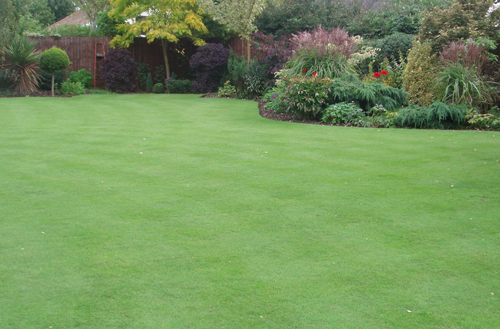April Garden Diary
Our April Garden Diary is brought to you by Geoff Hodge of the Scotts Miracle-Gro Company.
April weather can be very variable. Although warm spells are possible, so are gloomy days, cold nights and frosts. There’s always the chance of many April showers – or torrential downpours! These variable conditions can adversely affect plants, especially fresh, new growth and young vegetable plants.
FLOWER BEDS & BORDERS
Hardy annuals are the quick and easy way to produce colourful summer borders – you simply sow the seeds outdoors where you want them to flower. There are dozens of types to choose from, including the popular Calendula (pot marigolds), Eschscholzia (Californian poppies), Limnanthes, Lobularia and Nemophila.
For a more natural looking, cottage garden effect, mark out different shaped seedbeds and broadcast the seeds of different varieties over the soil in each area and rake in. For a more formal look and feel, sow the seed in rows in these shaped areas. This also makes it is easier to distinguish between flower and weed seedlings, as you know where the flower seed has been sown.
 For a really simple way of creating colourful annual flower borders, use Miracle-Gro Flower Magic, which is available in three colour blends. Its 3-in-1 mixture of premium flower seeds, slow-release Miracle-Gro plant food and coir compost is simply sprinkled over the prepared soil from the shaker jug. The food feeds the plants for up to four months and the compost takes care of the seeds and seedlings as they grow. The coir compost absorbs water like a sponge when wetted, expanding instantly to surround the seeds in a moist, protective layer. It continues to care for the seedlings, providing them with water and nutrients, so they produce strong plants.
For a really simple way of creating colourful annual flower borders, use Miracle-Gro Flower Magic, which is available in three colour blends. Its 3-in-1 mixture of premium flower seeds, slow-release Miracle-Gro plant food and coir compost is simply sprinkled over the prepared soil from the shaker jug. The food feeds the plants for up to four months and the compost takes care of the seeds and seedlings as they grow. The coir compost absorbs water like a sponge when wetted, expanding instantly to surround the seeds in a moist, protective layer. It continues to care for the seedlings, providing them with water and nutrients, so they produce strong plants.
When spring-flowering bulbs have finished flowering, they start to build up their strength and produce their flower buds for next year’s display. Some care and attention now will help to ensure a fabulous floral feast next spring.
Deadhead the plants once the flowers have faded by carefully pulling or cutting off the developing seed heads, leaving the stems and leaves to die down naturally. It may be tempting to remove the foliage or tie it into neat knots, but the bulbs need the leaves to feed them. Give them a feed every two or three weeks with Miracle-Gro All Purpose Soluble Plant Food until the foliage has turned yellow to further build up their strength.
Rhododendrons, azaleas and camellias should be flowering well by now. To keep them strong, healthy and flowering well they need a good feed. You can either use Miracle-Gro Azalea, Camellia & Rhododendron Soluble or Liquid Plant Food or Miracle-Gro Azalea, Camellia & Rhododendron Continuous Release Plant Food, which will keep plants well fed for up to six months from just one application. Continuous Release feeds are’‘smart feeds’ releasing their nutrients when the plants need them and for up to six months. This makes them perfect if you are short of time and don’t always remember to feed regularly with liquid feeds.
Topical tip
Annual climbers make colourful features, and even screens for disguising unsightly garden eyesores. Good choices include Eccremocarpus, Cobaea, Ipomoea, Tropaeolum, Rhodochiton and, of course, sweet peas (Lathyrus odoratus).
PATIO GARDENING
If you like the sound of how easy Miracle-Gro Flower Magic is for creating displays in beds and borders, then use Miracle-Gro Flower Magic Pots & Containers for your patio displays. It contains, shorter, more compact varieties, making it the perfect choice for containers. It has all the advantages of the other Miracle-Gro Flower Magic mixes.
Keep spring flower displays looking good and flowering well until they can be replaced with summer bedding by deadheading and feeding regularly with a water soluble or liquid feed, such as Miracle-Gro All Purpose Soluble Plant Food or Miracle-Gro All Purpose Concentrated Liquid Plant Food.
Topical tip
If primroses, polyanthus and other patio plants suddenly wilt, despite regular watering, then vine weevil grubs may be the culprits. If you find the root-eating grubs, treat the compost with BugClear Ultra Vine Weevil Killer.
LAWNS
Regular mowing removes a lot of nutrients, and for a lawn that looks fabulous, lush and green you need to replace these nutrients with a lawn feed. Feeding also makes the grass thicker, stronger and healthier, so it is better equipped to fight off moss, weeds and even drought stress. Granular feeds are best at this time of year, as they will feed the lawn for several weeks. EverGreen Extreme Green will start to green up the grass in just three days. EverGreen Complete 4 in 1 will feed the grass and deal with problem weeds and moss at the same time.
This is the time to do something about thin or patchy lawns and bare areas. Lightly fork over the soil in any bare areas and mix in some compost. Then lightly scatter grass seed over the soil at a rate of 25-30g per sq m (¾-1oz per sq yard). Lightly rake in the seed and water well with a watering can fitted with a fine rose. Or, to make this job simpler, just use Miracle-Gro Patch Magic! – simply loosen the soil in the bare area, sprinkle it on and water in well. It contains coir compost that looks after the new grass seedlings and Miracle-Gro Plant food that feeds them while they’re establishing.
If the overall grass cover is thin, you can dramatically improve your lawn by overseeding. Simply scatter grass seed over the whole lawn at the rate of 15-25g per sq m (½–¾oz per sq yard) and work it into the soil, or use Miracle-Gro Patch Magic!. This is how greenkeepers produce quality greens and pitches.
Topical tip
Never rake out live moss from the lawn, as this can spread it and make the problem even worse. Kill it first with a suitable lawn mosskiller, such as EverGreen Mosskil Soluble, before attempting to remove it.
GROW YOUR OWN
Vegetables
April is the main seed-sowing month in the veg garden and there are lots of crops to sow outside. These include beetroot, carrot, cauliflower, kohl rabi, leek, lettuce, parsnip, pea, radish, salad leaves, spinach, summer cabbage, Swiss chard and turnip.
This is also one of the best times to sow indoors with gentle heat all those crops that need a warmer start to life, including aubergine, cucumber, French bean, pumpkin and squashes, runner bean, sweet pepper and tomato. If you don’t have the facilities to grow these crops from seed, most are readily available as young plants from your garden centre.
 Early April is the time to plant out seed potatoes. There are a number of different ways to grow potatoes. The traditional method is to dig a trench and plant them 10cm (4in) deep. Alternatively, plant them shallowly through black plastic sheeting to prevent having to earth them up later on and reduce weed problems. You can even grow them in large pots or in a Miracle-Gro Gro Your Own gro-sac for potatoes and root vegetables on your patio.
Early April is the time to plant out seed potatoes. There are a number of different ways to grow potatoes. The traditional method is to dig a trench and plant them 10cm (4in) deep. Alternatively, plant them shallowly through black plastic sheeting to prevent having to earth them up later on and reduce weed problems. You can even grow them in large pots or in a Miracle-Gro Gro Your Own gro-sac for potatoes and root vegetables on your patio.
Topical tip
Young plants and newly emerging potato shoots can easily be damaged by strong, cold winds and frosts. So have some horticultural fleece or cloches, such as the Botanico Sun Tunnel, handy to protect them if adverse conditions are forecast.
Fruit
Container-grown fruit can be planted now, but try and get planting finished by the end of the month. Make sure the soil is well prepared before planting by digging in plenty of organic matter, such as Levington Organic Blend Soil Conditioner or Levington Organic Blend Farmyard Manure. Then add Miracle-Gro Bone Meal Natural Root Builder to help improve root growth and establishment. Mix in more organic matter with the soil dug out from the planting hole. Always plant at the same depth that the plant was originally growing and firm the soil around the roots.
Fruit trees will need to be staked with a good tree stake and secured with two tree ties.
Water in well and water thoroughly during prolonged dry weather. Mulch the soil with Miracle-Gro Moisture Control Decorative Pine Bark or Levington Water Saving Decorative Bark to help maintain soil moisture levels and keep weeds down.
This is a good time to plant outdoor grape vines. Grapes need deep, well-drained soils with lots of added organic matter, such as Levington Organic Blend Farmyard Manure. They also need a good feed with Miracle-Gro Growmore Garden Plant Food or Miracle-Gro Fish, Blood & Bone All Purpose Plant Food.
Topical tip
Wherever possible, net fruit crops to reduce pigeon damage, and to keep bullfinches off developing flower buds.
TREES, SHRUBS, ROSES & CLIMBERS
 Roses are one of our favourite garden plants, producing lots of colour during the summer – and usually well into autumn and even winter. Although some are resistant to diseases, others are much less so and will need protection against the three main rose diseases – powdery mildew, rust and blackspot. It’s important to spray with a fungicide at the first sign of disease attack, before it takes hold, and now’s the time to make a start. FungusClear Ultra is systemic and one of the best fungicides for protecting ornamental plants – including roses. RoseClear Ultra is a combined fungicide and insecticide, so will clear up and give protection against insect pests (see label for details) too.
Roses are one of our favourite garden plants, producing lots of colour during the summer – and usually well into autumn and even winter. Although some are resistant to diseases, others are much less so and will need protection against the three main rose diseases – powdery mildew, rust and blackspot. It’s important to spray with a fungicide at the first sign of disease attack, before it takes hold, and now’s the time to make a start. FungusClear Ultra is systemic and one of the best fungicides for protecting ornamental plants – including roses. RoseClear Ultra is a combined fungicide and insecticide, so will clear up and give protection against insect pests (see label for details) too.
There are numerous shrubs that need pruning this month:
Prune spring-flowering shrubs, such as Forsythia and flowering currant (Ribes), after they’ve finished flowering. Aim to completely remove one in three of the oldest flowering shoots and cut back some of the remaining shoots too.
Shrubs that are cut back hard to keep their larger or more colourful foliage, such as Cotinus (smoke bush), Eucalyptus and Sambucus (cut-leaved elders) are best pruned this month. Cotinus and Sambucus should have the stems produced last year cut back by around half to two-thirds. Eucalyptus can be cut back to strong growth just a few inches above ground level if necessary.
Lightly cut back or trim over lavender, Helichrysum (curry plant), Santolina (cotton lavender) and thyme. This will keep them bushy and flowering well. Never cut back into old, woody growth, as these plants rarely re-shoot from old wood.
Prune hardy fuchsias, penstemons and other slightly tender plants such as Artemisia and Phygelius. They can either be cut back hard, to just above new growth appearing at or just above ground level, or reduced in size by about half.
Clip over winter-flowering heathers as the flowers fade to prevent the plants getting straggly. Remove the faded flowers plus about an inch of leafy growth.
Feed all shrubs after pruning with Miracle-Gro Rose & Shrub Continuous Release Plant Food to help them produce good, flowering growth.
Topical tip
Don’t rush to dig up or prune plants damaged by frost or snow. Leave them until you see fresh new growth appearing, which can be as late as May/June. Then remove any dead growth, cutting back to a healthy new shoot or growing point. Give them a liquid feed to help them recover.
GENERAL GARDENING JOBS
Many plants can suffer from pest and disease attack. Pests particularly can quickly get out of control if you don’t spot them early. Regularly walking or patrolling your garden looking for problems and dealing with them quickly, will allow you to enjoy your garden much more. Having a ready-to-use insecticide, such as BugClear Ultra Gun! and BugClear Gun! For Fruit & Veg, and a fungicide, such as FungusClear Ultra Gun!, readily to hand means you can deal with pests and diseases as soon as they appear and before they become a problem. Always read the label before use to check the product is suitable for the problem and plants in question.
Weeds will also be growing strongly this month! One of the easiest ways of keeping them in check is to hoe the seedlings or young plants regularly. Or you could apply a 5-7.5cm (2-3in) deep mulch of Miracle-Gro Moisture Control Decorative Pine Bark or Levington Water Saving Decorative Bark to prevent annual weed growth in the first place. Perennial weeds with deep taproots, such as dandelions, or horizontal roots, such as ground elder, could be dug up using a hand fork or sprayed with a weedkiller containing glyphosate, such as Weedol Rootkill Plus or any Roundup product, which will kill the roots as well as the top growth.
As temperatures rise, and water in ponds warms up, this is a good time to start planting up ponds and adding new fish.
Topical tip
Frosts are still possible this month, so make sure tender plants are protected from the cold. Always have horticultural fleece on hand that can be thrown over the plants at night when frost is forecast.
HOUSEPLANTS
Houseplants will be growing strongly now, so check them regularly to make sure the compost doesn’t dry out. The aim should be to keep the compost just moist. Always use tepid water, not cold water straight from the tap, and make sure you don’t overwater – more houseplants are killed by overwatering than any other reason.
And, as they’re growing, you need to feed regularly throughout spring and summer with Miracle-Gro Pour & Feed.
Topical tip
Tidy up houseplants to remove yellowing and dead leaves and flowers that have gone over. This not only makes them look more attractive, but also helps reduce any build-up of problems.
Use plant protection products & biocides safely. Always read the label and product information before use. Pay attention to the risk indications and follow the safety precautions on the label.
BugClear™ Gun! for Fruit & Veg contains pyrethrins.
BugClear Ultra™ Gun! And BugClear Ultra™ Vine Weevil Killer contain acetamiprid.
EverGreen® Complete 4in1 contains MCPA, mecoprop-P and ferrous sulphate.
EverGreen Mosskil Soluble contains ferrous sulphate.
FungusClear® Ultra and FungusClear® Ultra Gun! contain triticonazole.
RoseClear® Ultra and RoseClear® Ultra Gun! contain triticonazole and acetamiprid.
The Roundup® range of products contain glyphosate.
Weedol® Pathclear™ Weedkiller contains glyphosate and diflufenican.
Weedol® Rootkill Plus contains glyphosate and pyraflufen ethyl.
Products marked ® and ™, Botanico, Miracle-Gro and Levington are trademarks of The Scotts Company LLC or its subsidiaries.
Roundup® is the registered trademark of Monsanto Technology LLC.




